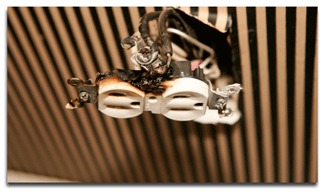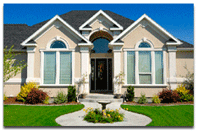Aluminum Wiring
Most
electrical wiring
is copper.
In the early 1960's the price of copper began to rise and aluminum
wiring was commonly used for residences from the mid-1960s through the
mid-1970s. There are several million homes in the US with aluminum
branch circuit wiring.
The Problem
There is
no problem
with the
aluminum wire itself within the walls; the problem is at the connection
points. First, aluminum expands and contracts more than copper when it
heats and cools. This can
cause fasteners to loosen. More importantly,
aluminum oxidizes easily and the oxide is a poor conductor. This causes
overheating at the connection points (the main source of trouble). A
further problem with some
aluminum wire is fatigue. The wire becomes
brittle and breaks if bent back and forth only a few times. Do
not
try to pull outlets and switches out of the wall to examine them
yourself. Leave this to a qualified licensed electrician who can fix
any problems that might be found.
The Result
These problems can
create
overheating and arcing at connection points which have led to fires
resulting in injury and deaths. Research sponsored by the Consumer
Product Safety Commission (CPSC) shows that homes wired with aluminum
wire manufactured before  1972
are 55 times more likely to have one or more connections reach "Fire
Hazard Conditions" than are homes wired with copper. [1, p.2] "Post
1972" aluminum wire is also a concern. A change in the aluminum wire
alloys in 1972 did not solve all of the known problems.
1972
are 55 times more likely to have one or more connections reach "Fire
Hazard Conditions" than are homes wired with copper. [1, p.2] "Post
1972" aluminum wire is also a concern. A change in the aluminum wire
alloys in 1972 did not solve all of the known problems.
The presence of aluminum wiring can almost always be detected during a
standard home inspection. However according to Dr. Jesse Aronstein "The
probability of aluminum-wired connection overheating in a home varies
considerably according to the types of connections, the installation
methods used, and the circuit usage, along with many other factors."
[2, p.1]
Problems with connections are not normally visible on the face plate.
You need to check every connection
throughout the house to know if a hidden problem is lurking somewhere
(this is not included in a standard home inspection by any company).
Even if the home
inspector does not report any other problems with the aluminum wiring
it is prudent to consult with a licensed electrician who is thoroughly
familiar with aluminum wiring problems for a more extensive evaluation.
A home inspection is only a first step in reducing risk.
The Solution
Currently,
only two
solutions have
been recommended by the CPSC. [1] The first solution is to replace the
aluminum wiring with copper. Sometimes this is possible, such as a
house with a full crawl space and attic, or a house with wiring
contained inside conduit. But in most cases re-wiring with copper is
likely to be cost prohibitive and impractical unless you plan on
extensive remodeling.
The second
solution
uses a special
crimp connection to splice a short piece of copper wire (called a
pig-tail) between the aluminum wire and the electrical device
(receptacle, switch, light, etc.). This connection can only be made
using a special crimp-type connector made by the AMP Corporation (the
COPALUM connector). [3] Proper use of this method requires specialized
training, and it's only available to licensed electricians. Contact the
AMP Corporation to find out who in your area is currently licensed to
make repairs using the COPALUM crimp method.
There are other (and cheaper) repair methods, but they don't reduce the
risk as much. The homeowner has some choices to make. You can find out
more about these other methods in Dr. Aronstein's paper [Ref. 2].
Although this paper is lengthy and technical, it's also comprehensive.
You can find a copy on-line at
http://www.inspect-ny.com/aluminum/alreduce.htm
In
closing, remember
that any
repair work should be performed only by a licensed electrician
thoroughly familiar with aluminum wiring. You can find more
information on problems with aluminum wiring at:
http://www.inspect-ny.com/aluminum.htm
References
[1] "Repairing
Aluminum Wiring"; CPSC Publication #516; Consumer Product
Safety Commission, http://cpsc.gov;
Washington, D.C. 20207 (printed copies available free to the public).
[2] "Reducing The Fire Hazard In Aluminum-Wired
Homes";
Jesse Aronstein, Ph.D., PE (When originally written: Vice President,
Special Engineering Projects Wright-Malta Corp., Ballston Spa, NY);
Updated September 12, 2000; (Original: January 25, 1982) This report
was originally prepared for: Electrical Safety Conference - Electrical
Fires, University of Wisconsin-Extension; Madison, Wisconsin; 4/14/82.
[3] Amp
Incorporated, http://www.amp.com
PO Box 3608, Harrisburg, PA 17105-3608, 1-800-522-6752.


I adhere
to the NACHI Standards of Practice
and the NACHI Code of Ethics.
NACHI Standards of Practice
NACHI
Code of Ethics
Proudly
Serving the Following Counties:
Ada, Adams, Boise, Canyon, Gem, Payette,
Valley, Washington and Malheur
Oxbow Home Inspections • PO Box 2144 Eagle, ID 83616• 208.573.5300
Troy Farmer: Owner/Inspector • E-Mail: info@troyfarmer.com
© 2007- 2010 Oxbow Home
Inspections and Radon Testing, LLC





